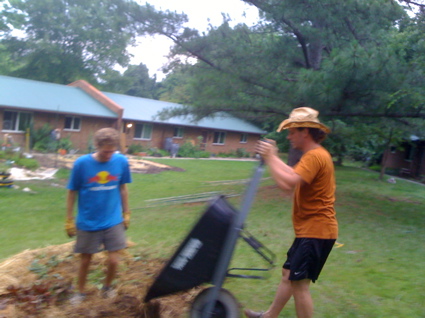 Carbon sequestration: Crop Mob stalwarts Rob Jones, left, and Chris Rumbley create a hügelkultur bed at “the Bog” co-housing community in Carrboro, N.C., summer 2009. Photo: Tom PhilpottA growing number of young people are finishing college and resisting the pressure to plunk down in a cube behind a computer. Others skip college altogether–given the spiraling costs involved, it’s hard to blame them–and yearn for meaningful, hands-on work.
Carbon sequestration: Crop Mob stalwarts Rob Jones, left, and Chris Rumbley create a hügelkultur bed at “the Bog” co-housing community in Carrboro, N.C., summer 2009. Photo: Tom PhilpottA growing number of young people are finishing college and resisting the pressure to plunk down in a cube behind a computer. Others skip college altogether–given the spiraling costs involved, it’s hard to blame them–and yearn for meaningful, hands-on work.
Community-scale organic farming has emerged as an attractive profession for such talented, energetic youth. But there are problems with this choice. Hours are long, the pay too often stinks, and land prices remain crushingly high. To top it off, our nation lacks universal health coverage.
Yet youthful zeal to farm abides, and hasn’t let up, as far as I can tell. This is a major asset to the sustainable food movement. As our nation’s million or so active farmers nears retirement age, an emerging generation of landless farmers is rising.
One of the main challenges of the movement will be to help find them land and create the infrastructure needed to make farming a viable profession.
Meanwhile, all over the country, the kids are organizing themselves, teaming together, harnessing their energy and keeping the vision of a just and sustainable food system alive and moving forward.
One of the most vital such projects I know of is the Crop Mob in the North Carolina Triangle (Durham, Raleigh, Chapel Hill). I know many of the Mobbers–two of them were my neighbors in Carrboro when my girlfriend was working on a PhD at UNC.
So I was thrilled to see them featured in the coming Sunday’s New York Times Magazine, in a well-written article by Christine Muhlke.
The Mob is essentially a group of young people of all ages (at the ripe age of 44, I have participated) who alight upon an area farm once a month and do a whole bunch of work together: weeding, moving compost, digging up fresh beds, harvesting ready-at-once crops like sweet potatoes. In short, the kind of work that seems crushing when one or two people set out to do it, but that’s downright fun with a crowd. When the work is done, everyone sits down for a meal.
In one of Wendell Berry’s books, he relays the old farm saying, “many hands make light work.” The Mob illustrates that principle.
 Sweet-potato harvest: Piedmont Bio-Farm in Pittsboro, N.C., gets mobbed, December, 2009.Photo: Tom PhilpottThe group is open and informal; anyone can attend its monthly work sessions. Typical attendees include young farmers, low-paid but well-fed farmhands who would like to have their own farms, college students, and citizens who just want to get their hands in the dirt and pitch in for their foodshed.
Sweet-potato harvest: Piedmont Bio-Farm in Pittsboro, N.C., gets mobbed, December, 2009.Photo: Tom PhilpottThe group is open and informal; anyone can attend its monthly work sessions. Typical attendees include young farmers, low-paid but well-fed farmhands who would like to have their own farms, college students, and citizens who just want to get their hands in the dirt and pitch in for their foodshed.
Do any of those categories fit you? If so, start your own Crop Mob! As my friend and former neighbor Rob Jones told Muhlke, a Mob can break out anywhere:
The idea is catching on, Jones said. Requests for advice on starting mini-Mobs have come in from around the state. Two Crop Mobbers are traveling to Spain to talk to farmers. In cities, Jones added, there’s no reason that backyard and community gardeners can’t mob, too. Because anywhere there’s dirt, a community can grow.
I was also thrilled to see another friend, the wonderful chef Andrea Ruesing of Chapel Hill’s Lantern restuarant, get some love from the Times Magazine. The coming issue features two recipes from Andrea (here and here), plus another from Lantern’s talented pastry chef Monica Segovia-Welsh.
Triangle, represent!



